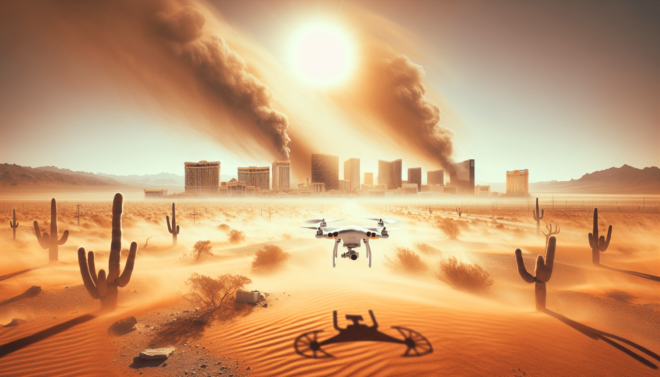Why would anyone choose to fly a drone in Las Vegas, especially when the weather turns extreme? Let’s explore why this can be particularly hazardous in conditions of high winds or scorching heat. As a drone enthusiast, understanding these risks will not only protect your equipment but also keep you on the right side of safety and the law.
The Allure of Flying Drones in Las Vegas
Las Vegas, with its striking landscapes and iconic skyline, offers a unique backdrop for drone photography and videography. The vibrant cityscape, coupled with the surrounding desert terrain, provides ample opportunity for creativity and aerial exploration. However, these same conditions that might attract you also harbor challenges that can turn your drone-flying experience upside down.
Las Vegas Weather Overview
Before diving into the specifics of why certain weather conditions can be perilous for drones, it’s essential to understand the broader climate profile of Las Vegas. The city is nestled in the Mojave Desert, known for its temperature extremes and erratic weather patterns.
-
Summer Heat: Summers in Las Vegas are notoriously hot, with average high temperatures routinely exceeding 100°F (38°C). Such conditions can have a dramatic impact on electronic devices, including drones.
-
Windy Conditions: Las Vegas also experiences significant wind episodes, particularly between March and June. These high winds can be sudden and unpredictable, causing havoc for any airborne objects.
-
Other Weather Phenomena: Though not as frequent, dust storms and rapid weather changes can also pose risks, further complicated by the heat and high winds.
Why High Winds Pose a Threat to Drones
While flying a drone can be an exhilarating experience, the last thing you want is to fight against strong winds. Wind not only complicates control plans but can also result in irreversible damage to your drone.
Challenging Control and Stability
High winds can severely limit your ability to maintain control over your drone. With wind speeds frequently surpassing the capability of many consumer drones, keeping your device stable can become an overwhelming task.
- Gusts and Turbulence: Sudden gusts can knock your drone off its intended path, causing abrupt movements that might lead to crashes.
- Battery Drain: Fighting against the wind requires more power, leading to a faster battery drain which limits flight time and increases the risk of the drone losing power and crashing.
Increased Risk of Crashes
The potential for crashes is considerably higher in windy conditions. High winds can push your drone into obstacles or make it difficult to land safely.
| Wind Speed (mph) | Potential Impact |
|---|---|
| 0 – 5 | Ideal flying conditions. |
| 6 – 10 | Minor impacts on control, manageable for most drones. |
| 11 – 15 | Noticeable effects on stability; increased control required. |
| 16 – 20 | Significant effort needed; increased crash risk. |
| 21+ | Not recommended; severe control issues likely. |
How to Mitigate Risks in Windy Conditions
Preparation and precautionary measures can help you mitigate these risks. Fly your drone in areas shielded from strong winds, keep flight times short, and avoid flying at high altitudes. Always ensure your drone’s settings are adjusted for windy conditions if possible.
The Perils of Extreme Heat on Drones
While wind affects maneuverability, extreme heat predominantly poses a threat to the internal components of your drone. Let’s examine why high temperatures can be problematic.
Impact of Heat on Drone Performance
Drones are electronic devices sensitive to thermal conditions. Extreme heat can lead to overheating, which adversely affects performance and durability.
- Battery Efficiency: High temperatures can cause batteries to deplete faster or malfunction. A depleted battery can result in unexpected power loss mid-flight.
- Component Degradation: Heat can expedite wear and tear of electronic components, impacting your drone’s long-term reliability.
Consequences of Overheating
An overheated drone could experience performance lag, unintended shutdowns, or even damage to critical internal hardware.
Signs of an Overheated Drone
- Rapid Battery Drain: Noticed by significantly reduced flight times.
- Lag or Glitches: Delayed response to controls can indicate overheating.
- Warning Alerts: Pay heed to any warnings from your drone’s system.
Protecting Your Drone from Heat
Operating in extreme temperatures necessitates some precautions:
- Limit Flight Duration: Shorter flights reduce the exposure of sensitive components to excessive heat.
- Cool Down Time: Allow your drone a cooling period between flights to prevent overheating.
- Environment Selection: Opt for shaded areas or times of day when temperatures are lower, like early morning or late afternoon.
Legal Considerations of Drone Flying in Adverse Weather
The safety risks associated with flying in extreme weather aren’t only physical but legal, too. You must always consider the regulations and guidelines set forth by aviation and local authorities.
FAA and Drone Regulations
The Federal Aviation Administration (FAA) outlines specific guidelines for drone operation, including those influenced by weather. They advise against flying in poor weather conditions that could compromise safety.
Local Regulations in Las Vegas
Clark County, where Las Vegas is situated, imposes additional regulations. Ensure you are aware of local laws relating to where and how you can fly drones, regardless of weather conditions.
Risk of Accidents and Liability
Accidents caused by negligence in adverse conditions could expose you to legal actions or penalties. Overlooking guidelines can result in fines or suspension of flying privileges.
Conclusion: Safety First
Flying a drone in Las Vegas during high winds or extreme heat can be an exhilarating challenge for even the most experienced drone pilot. However, it requires a deep understanding of the risks and reinforced safety procedures. Be prepared, prioritize safety, and respect the limitations imposed by environmental factors. By doing so, you’ll not only protect your drone but also enhance your skill as a responsible operator. So next time you find yourself drawn to the desert sky, remember these insights to ensure every flight is both thrilling and safe.

